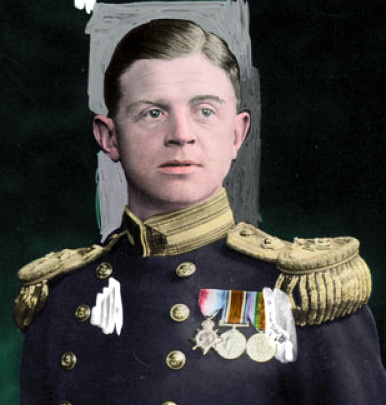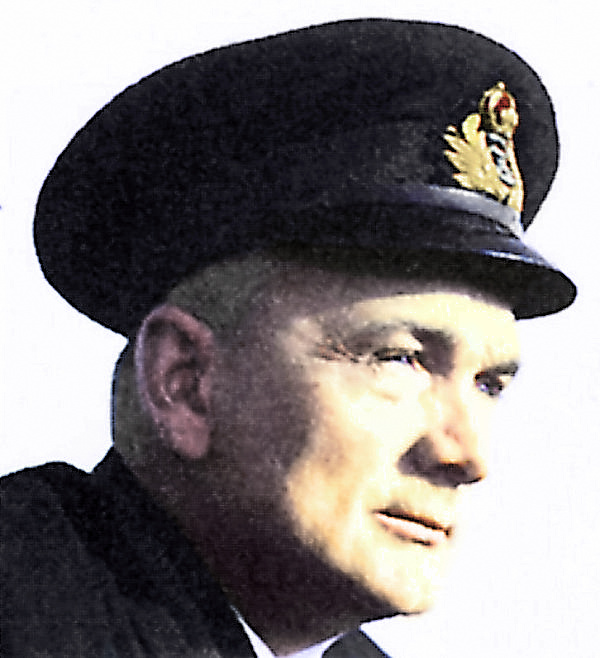Before starting off, a brief summary about the VC in World War II:
The following posts are of the recipients of the Victoria Cross for action in World War II. The Victoria Cross was awarded 182 times to 181 recipients.
The first Victoria Cross of the war was awarded to Gerard Roope for action whilst in command of HMS Glowworm.
Charles Upham received the Victoria Cross and Bar; two awards for two acts. Upham was only the third recipient of the Victoria Cross and Bar, and the first for combatant actions; the previous two recipients were medical officers of the Royal Army Medical Corps.
Of the 181 recipients, 85 were awarded posthumously.
3 Likes
Gerard Broadmead Roope (1905-1940)
Royal Navy (HMS Glowworm)
April 8, 1940
Norwegian Sea, off Trondheim
Posthumous

His Victoria Cross citation:
The late Lieutenant-Commander Gerard Broadmead ROOPE, Royal Navy. On the 8th April, 1940, H.M.S. Glowworm was proceeding alone in heavy weather towards a rendezvous in West Fjord, when she met and engaged two enemy destroyers, scoring at least one hit on them. The enemy broke off the action and headed North, to lead the Glowworm on to his supporting forces. The Commanding Officer, whilst correctly appreciating the intentions of the enemy, at once gave chase. The German heavy cruiser, Admiral Hipper, was sighted closing the Glowworm at high speed and an enemy report was sent which was received by H.M.S. Renown. Because of the heavy sea, the Glowworm could not shadow the enemy and the Commanding Officer therefore decided to attack with torpedoes and then to close in order to inflict as much damage as possible. Five torpedoes were fired and later the remaining five, but without success. The Glowworm was badly hit; one gun was out of action and her speed was much reduced, but with the other three guns still firing she closed and rammed the Admiral Hipper. As the Glowworm drew away, she opened fire again and scored one hit at a range of 400 yards. The Glowworm, badly stove in forward and riddled with enemy fire, heeled over to starboard, and the Commanding Officer gave the order to abandon her. Shortly afterwards she capsized and sank. The Admiral Hipper hove to for at least an hour picking up survivors but the loss of life was heavy, only 31 out of the Glowworm’s complement of 149 being saved.
4 Likes
Bernard Armitage Warburton Warburton-Lee (1895-1940)
Royal Navy (HMS Hardy)
April 10, 1940
Ofotfjord, Norway
Posthumous

His Victoria Cross citation:
For gallantry, enterprise and daring in command of the force engaged in the First Battle of Narvik, on 10th April, 1940. On being ordered to carry out an attack on Narvik, Captain Warburton-Lee learned that the enemy was holding the place in much greater force than had been thought. He signalled to the Admiralty that six German destroyers and one submarine were there, that the channel might be mined, and that he intended to attack at dawn. The Admiralty replied that he alone could judge whether to attack, and that whatever decision he made would have full support. Captain Warburton led his flotilla of five destroyers up the fjord in heavy snow-storms, arriving off Narvik just after daybreak. He took the enemy completely by surprise and made three successful attacks on warships and merchantmen in the harbour. As the flotilla withdrew, five enemy destroyers of superior gunpower were encountered and engaged. The captain was mortally wounded by a shell which hit the bridge of H.M.S. Hardy. His last signal was “Continue to engage the enemy”.
4 Likes
Richard Been Stannard (1902 -1977)
Royal Naval Reserve (HMT Arab)
April 28 - May 2, 1940
Namsos, Norway

His Victoria Cross citation:
The KING has been graciously pleased to approve the grant of the Victoria Cross to Lieutenant Richard Been Stannard, R.N.R., H.M.S. Arab, for outstanding valour and signal devotion to duty at Namsos. When enemy bombing attacks had set on fire many tons of hand grenades on Namsos wharf, with no shore water supply available, Lieutenant Stannard ran Arab’s bows against the wharf and held her there. Sending all but two of his crew aft, he then endeavoured for two hours to extinguish the fire with hoses from the forecastle. He persisted in this work till he had to give up the attempt as hopeless.
After helping other ships against air attacks, he placed his own damaged vessel under shelter of a cliff, landed his crew and those of two other trawlers, and established an armed camp. Here those off duty could rest while he attacked enemy aircraft which approached by day, and kept anti-submarine watch during the night.
When another trawler near-by was hit and set on fire by a bomb, he, with two others, boarded Arab and moved her 100 yards before the other vessel blew up. Finally, when leaving the fjord, he was attacked by a German bomber which ordered him to steer East or be sunk. He held on his course, reserved his fire till the enemy was within 800 yards, and then brought the aircraft down.
Throughout a period of five days Arab was subjected to 31 bombing attacks and the camp and Lewis gun positions ashore were repeatedly machine-gunned and bombed; yet the defensive position was so well planned that only one man was wounded.
Lieutenant Stannard ultimately brought his damaged ship back to an English port. His continuous gallantry in the presence of the enemy was magnificent, and his enterprise and resource not only caused losses to the Germans but saved his ship and many lives.
3 Likes


